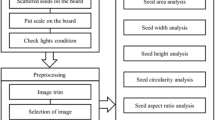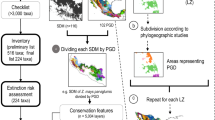Abstract
Two cycles of recurrent phenotypic selection with a weighted Euclidean distance index based on flower colour were applied to individual plants sampled from the Davis population of gerbera (Gerbera jamesonii H. Bolus ex Hooker). The index (I) included CIELAB (1976) variables hue (H), chroma (C) and value (L). The narrow-sense heritability (h2) for I in cycle 0 was estimated at more than 1.0 by half-sib family means and consequently overestimated the selection response. However, the genetic variance was exhausted after two cycles of selection and genetic correlations among the component traits of the index became increasingly positive. Complex segregation analysis (CSA) of index scores in the Davis population supports a mixed Mendelian model with a completely dominant segregating major gene accounting for 20 per cent of the phenotypic variance. This model estimates h2 = 0.9 for I and is discussed as it pertains to the effects of selection on the genetic parameters of the selected population.
Similar content being viewed by others
Article PDF
References
Akaike, H. 1974. A new look at the statistical model identification. IEEE Trans Aut Control, AC-19, 716–723.
Baker, L H, and Curnow, R N. 1969. Choice of population size and use of variation between replicate populations in plant breeding selection programs. Crop Sci, 9, 555–560.
Bulmer, M G. 1971. The effect of selection on genetic variability. Am Nat, 105, 201–211.
Bonney, G E. 1984. On the statistical determination of major gene mechanisms in continuous human traits: regressive models. Am J Med Genet, 18, 731–749.
Byrne, T G, Harding, J, and Nelson, R L. 1977. Greenhouse gerberas. Calif Agric, 31, 21–22.
Cannings, C, Thompson, E A, and Skolnick, M H. 1978. Probability functions on complex pedigrees. Adv Appl Prob, 10, 26–61.
Chevalet, C. 1994. An approximate theory of selection assuming a finite number of quantitative trait loci. Génét Sél Évol, 26, 379–400.
Comstock, R E, and Robinson, H E. 1948. The components of genetic variance in populations of biparental progenies and their use in estimating the average degree of dominance. Biometrics, 4, 254–266.
Crow, J F, and Kimura, M. 1970. An Introduction to Population Genetics Theory. Harper & Row, New York.
Demenais, F, Lathrop, M, and Lalouel, J M. 1986. Robustness and power of the unified model in the analysis of quantitative measurements. Am J Hum Genet, 38, 228–234.
Edwards, A W F. 1978. Likelihood An Account of the Statistical Concept of Likelihood and its Application to Scientific Inference, 2nd edn. Cambridge University Press, London.
Elston, R C. 1993. Some recent developments in the theoretical aspects of segregation analysis. In: P. P. Majumder (ed.) Human Population Genetics. Plenum Press, New York.
Elston, R C, and Stewart, J. 1971. A general model for the genetic analysis of pedigree data. Hum Hered, 21, 523–542.
Falconer, D S. 1989. Introduction to Quantitative Genetics, 3rd edn. Longman Scientific and Technical, New York.
Gomez-Raya, L, and Burnside, E B. 1990. The effect of repeated cycles of selection on genetic variance, heritability and response. Theor Appl Genet, 79, 568–574.
Harding, J, Byrne, T, Huang, H, and Yu, Y. 1991. Multi-trait selection in flower crops. In: Harding, J., Singh F. and Mol, J. N. M. (eds.) Genetics and Breeding of Ornamental Species, pp. 157–178. Kluwer Academic, Boston.
Hospital, F, and Chevalet, C. 1993. Effects of population size and linkage on optimal selection intensity. Theor Appl Genet, 86, 775–780.
Khoury, M J, Beaty, T H, and Cohen, B H. 1993. Fundamentals of Genetic Epidemiology. Oxford University Press, New York.
Lerner, I M. 1950. Population Genetics and Animal Improvement. Cambridge University Press, London.
McGuire, R G. 1992. Reporting of objective color measurements. Hortscience, 27, 1254–1255.
Pesek, J, and Baker, R J. 1969. Desired improvement in relation to selection indices. Can J Plant Sci, 49, 803–804.
SAS Institute. 1985. SAS User's Guide Basics, Version 5. SAS Institute, Cary, NC.
SAS Institute. 1988. SAS/STAT User's Guide, Release 6.03. SAS Institute, Cary, NC.
Sheridan, A K, and Barker, J S F. 1974. Two-trait selection and genetic correlation. II. Changes in genetic correlation during two-trait selection. Aust J Biol Sci, 27, 89–101.
Tourjee, K R, Harding, J, and Byrne, T G. 1993. Colorimetric analysis of Gerbera flowers. Hortscience, 28, 735–737.
Tourjee, K R, Harding, J, and Byrne, T G. 1995. Complex segregation analysis of Gerbera flower colour. Heredity, 74, 303–310.
Voss, D H. 1992. Relating colorimeter measurement of plant color to the Royal Horticultural Society colour chart. Hortscience, 27, 1256–1260.
Weber, G, and Wricke, W E. 1986. Quantitative Genetics and Selection in Plant Breeding. W. de Gruyter, New York.
Yu, Y, Harding, J, and Byrne, T. 1993. Quantitative genetic analysis of flowering time in the Davis population of gerbera. II. Correlations with yield, flower quality traits and the efficiency of indirect selection. Euphytica, 70, 97–103.
Author information
Authors and Affiliations
Rights and permissions
About this article
Cite this article
Tourjee, K., Harding, J. & Byrne, T. Interpretation of a selection plateau through complex segregation analysis: Euclidean distance index selection for flower colour in the Davis population of Gerbera. Heredity 75, 290–296 (1995). https://doi.org/10.1038/hdy.1995.137
Received:
Issue date:
DOI: https://doi.org/10.1038/hdy.1995.137



